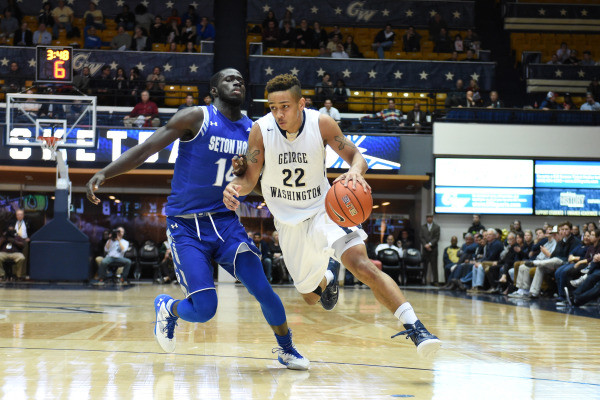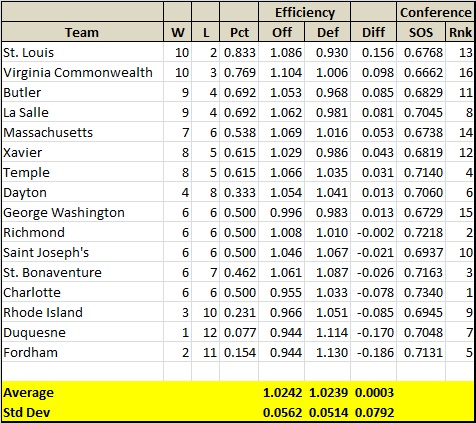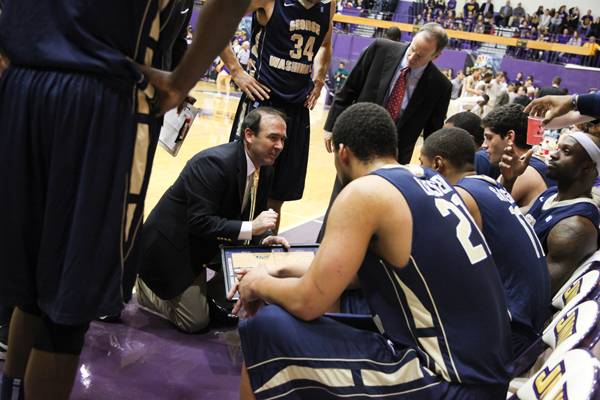Posted by CNguon on February 20th, 2013

Joe Dzuback is the RTC correspondent for the Atlantic 10 Conference. You can also find his musings online at Villanova by the Numbers or on Twitter @vtbnblog.
*Ed. Note: the statistics in this column were aggregated prior to Tuesday night’s St. Louis-VCU game.
Looking Back
Difference Margins in Conference Games: The offense/defense difference margins are beginning to “behave” as teams with winning records (Charlotte and Temple excepted) have positive difference margins, while teams with losing records (Dayton excepted) have negative difference margins. Temple, with a 5-5 record, has a -0.001, just two one-thousandths under “positive.” Tiers within the winning and losing groups continues to be messy, and occasionally explains why a team is succeeding or failing.
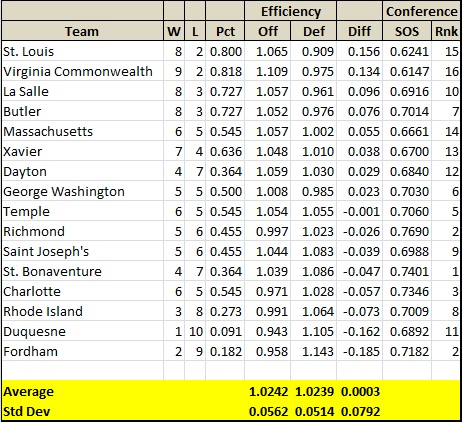
Looking over the “standings” this week a few things jump out…
- Fordham and Duquesne are losing contact with the rest of the conference, and that includes 3-8 Rhode Island. For the Dukes, with a new coach and a program in disarray, the trend is not surprising as wins are hard to come by. Fordham, coming into the season with senior all-conference forward Chris Gaston and a promising young backcourt, has to be a disappointment to fans and university administrators. Granted, Gaston has struggled with injuries and extended absences, but the current late season fade continues a pattern established over the last five seasons.
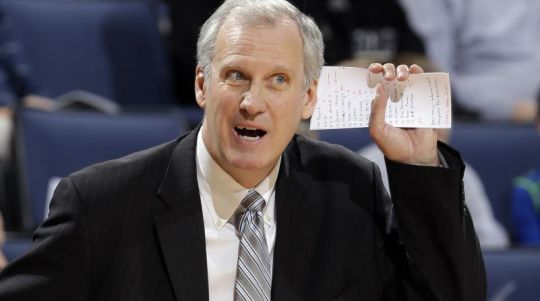
What’s that you say? Jim Crews and Saint Louis are running away from the rest of the conference. (AP)
- Saint Louis appears to be running away from the rest of the league. If the Bilikens’ numbers hold up over the course of this week (they play Butler next, after eviscerating VCU last night), expect coach Jim Crews’ squad to emerge with the #1 seed going into Brooklyn and up in the NCAA field where they are currently seeded in the #9-#11 range.
- Temple’s -0.001 efficiency margin reflects the fact that the Owls have had a series of one-point decisions (more in Temple’s team report below) against both stronger teams (Charlotte) and weaker teams (Duquesne).
Going, going… The topic touched on during virtually every Division I basketball game over the last week is “Who is in?” usually accompanied by a discussion of bubble teams – right side/wrong side, S-curves and “What happened to…”. Alhough the field is still under construction and opinions vary as to whether the Atlantic 10 will have six bids (Jerry Palm as of February 17) or four (Joe Lunardi and RTC’s own Daniel Evans), there is an emerging consensus that several preview “contenders” are in the field, somewhere on (or near) the bubble and clearly out of the conversation entirely. Some quick takes on the “bubble… sort of’s” and those who are “out”:
- Charlotte – Jerry Palm lists the 49ers as a #11 seed and well beyond the “Last Four In” category. Daniels lists them on his bubble watch of February 18 while Lunardi remains silent. Can good conference wins versus Butler and Xavier really negate double-figure losses to Richmond, George Washington and Saint Louis? More than any A-10 team not named Temple, winning their last five games going into the conference tournament will make or break this resume. Read the rest of this entry »
| checking in on, microsites, other 26
| Tagged: alan major, andrew smith, archie miller, Branden Frazier, butler, charlotte, chaz williams, chris gaston, chris mooney, cody ellis, dan hurley, dayton, demario mayfield, derek kellog, derrick colter, dj peterson, dr. john giannini, duquesne, Dwayne Evans, eric mosley, fordham, fran dunphy, george washington, isaiah armwood, jake barnett, jeremiah jones, jerrell wrights, jerry jones, jesse morgand, jim crews, jim gerry, joe mcdonald, jordan gaithers, kevin dillard, kevin larsen, khalif wyatt, khari price, khyle marshall, la salle, mark schmidt, massachusettes, massachusetts, Matt Derenbecker, mike lonergan, patricio garino, phil martelli, quevyn winters, rhode island, richmond, rohan brown, roosevelt jones, saint joseph's, shaka smart, st bonaventure, temple, teve zack, tom pecora, vee sanford, virginia commonwealth, xavier
Share this story
